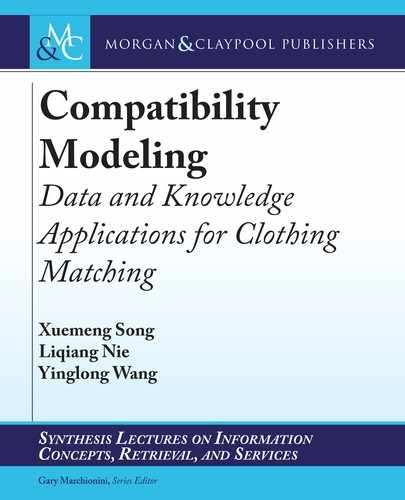5.4. EXPERIMENT 57
AUC [99, 133] as the evaluation metric. For optimization, we employed the stochastic gradient
descent (SGD) [3]. In particular, we applied a non-negative constraint in each iteration to op-
timize NMF. We adopted the grid search strategy to determine the optimal values on a set of
validation data temporarily split from the S
train
for the regularization parameters (i.e., , and
) among the values f10
r
jr 2 f4; : : : ; 1gg, Œ0:2; 0:4; 0:6; 0:8 and Œ0:05; 0:1; 0:2; 0:3, respec-
tively. In addition, the number of hidden units and learning rate are searched in Œ128; 256; 512
and Œ0:0001; 0:0005; 0:001, respectively. e proposed model is fine-tuned for 200 epochs, and
the performance on the testing set is reported. We empirically found that the proposed model
achieves the optimal performance with K D 1 hidden layer of 256 hidden units.
5.4.2 ON COMPARISON OF APPROACHES (RQ1)
As for the compatibility modeling, we chose the following content-based baselines to evaluate
the proposed model.
• POP: We used the “popularity” of bottom b
j
to measure its compatibility with top t
i
.
Here the “popularity” is defined as the number of tops that has been paired with b
j
in the
training set.
• RAND: We randomly assigned the compatibility scores of s
ij
and s
ik
between items.
• Bi-LSTM: We chose the bidirectional long short-term memory (LSTM) model in [31]
which explores the outfit compatibility by sequentially predicting the next item condi-
tioned on previous ones. In our context, we adapted Bi-LSTM to deal with an outfit
comprising of a top and a bottom.
• ExIBR: We extended the image-based recommendation (IBR) method proposed in [86]
to ExIBR to handle both the visual data and the structured category label of fashion items.
• BPR-DAE: We selected the content-based neural scheme introduced by [108] to jointly
model the coherent relation between different modalities of fashion items and the implicit
preference among items via a dual autoencoder network.
To compare all the approaches fairly, we utilized both the visual image and category meta-
data in Bi-LSTM, ExIBR, BPR-DAE, and PAICM. Table 5.3 shows the performance com-
parison among different approaches. As we can see, PAICM outperforms all the other baselines,
indicating the superiority of introducing the semantic attribute representations to the compat-
ibility modeling. One possible explanation is that the compatibility modeling task is indeed to
model the complicated interactions among various attributes of fashion items, and our semantic
attribute representation seems to be just task-oriented.
Moreover, as the prototype learning plays a pivotal role in our PAICM, we particularly
investigate the impact of the number of the prototypes learned by the NMF on the performance
of compatibility modeling. For simplicity, we adopted the same number of the compatible and
..................Content has been hidden....................
You can't read the all page of ebook, please click here login for view all page.
